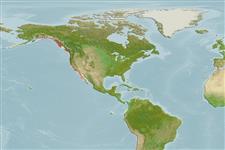Environment: milieu / climate zone / depth range / distribution range
Ecologia
marino demersale; distribuzione batimetrica 0 - ? m. Subtropical
Eastern Pacific: Kakul Narrows, southeastern Alaska to St. Nicholas Island and northern Baja California, Mexico.
Size / Peso / Age
Maturity: Lm ? range ? - ? cm
Max length : 6.4 cm TL maschio/sesso non determinato; (Ref. 2850)
Short description
Chiavi di identificazione | Morfologia | Morfometria
Spine dorsali (totale) : 8 - 10; Raggi dorsali molli (totale) : 16 - 19; Spine anali: 0; Raggi anali molli: 13 - 15. Caudal fin barely rounded.
Intertidal (Ref. 31184). Occurs in rocky areas and in kelp beds (Ref. 2850). Usually caught from lower tide pools (farthest from shore) (Ref. 2850). Can leave tide pools when aquatic conditions become inhospitable (Ref. 31184). Breathes air when out of water (Ref. 31184).
Life cycle and mating behavior
Maturities | Riproduzione | Spawnings | Egg(s) | Fecundities | Larve
Eschmeyer, W.N., E.S. Herald and H. Hammann, 1983. A field guide to Pacific coast fishes of North America. Boston (MA, USA): Houghton Mifflin Company. xii+336 p. (Ref. 2850)
IUCN Red List Status (Ref. 130435)
Threat to humans
Harmless
Human uses
Strumenti
Special reports
Download XML
Fonti Internet
Estimates based on models
Preferred temperature (Ref.
123201): 8.5 - 17.1, mean 10.1 °C (based on 205 cells).
Phylogenetic diversity index (Ref.
82804): PD
50 = 0.5625 [Uniqueness, from 0.5 = low to 2.0 = high].
Bayesian length-weight: a=0.00676 (0.00300 - 0.01523), b=3.17 (2.98 - 3.36), in cm total length, based on LWR estimates for this (Sub)family-body shape (Ref.
93245).
Trophic level (Ref.
69278): 3.1 ±0.3 se; based on size and trophs of closest relatives
Resilienza (Ref.
120179): Alto, tempo minimo di raddoppiamento della popolazione meno di 15 mesi (Preliminary K or Fecundity.).
Fishing Vulnerability (Ref.
59153): Low vulnerability (10 of 100).
